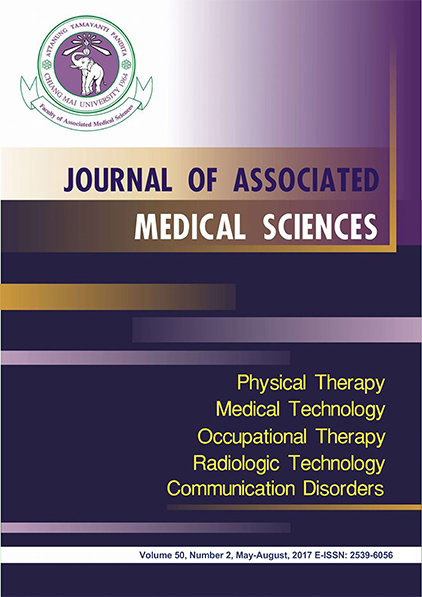Effects of educational and back exercise program in transfer workers with chronic low back pain
Main Article Content
Abstract
Background: Chronic low back pain is a common problem found in transfer workers. Back education and back exercise program may help to decrease pain intensity and improve functional capacity in transfer workers.
Objectives: To examine the effects of educational and back exercise program on pain intensity, functional capacity, and back pain knowledge in transfer workers with chronic low back pain.
Materials and methods: Forty male transfer workers with chronic low back pain were randomly assigned to intervention group (n=20 mean age 40.25±10.6) and control group (n=20 mean age 37.55±10.6). Participants in the intervention group received back educational program which composed of 1 hour of lecture and 3 hours of practical session. Then, they performed back exercise program at home for 20 minutes per session, 3 times a week for 12 weeks. Pain intensity, functional capacity and back pain knowledge were evaluated using visual analog scale, Oswestry disability index, and knowledge test respectively. All evaluations were performed before and after 12 weeks periods. Differences between and within groups in pain intensity were analyzed using independent t-test and paired t-test. Nonparametric statistics were used to analyze functional capacity and back pain knowledge. Significance level was set at p<0.05.
Results: At 12-week of educational and back exercise program, the intervention group demonstrated significant improvement in functional capacity and back pain knowledge when compared to baseline (p<0.05) and control group (p<0.05). However, no significant difference in pain intensity was found for both within and between group comparisons (p>0.05).
Conclusion: Back education and back exercise of 20 minutes per session, 3 times a week for 12 weeks could improve functional capacity and back pain knowledge in transfer workers with chronic low back pain.
Journal of Associated Medical Sciences 2017; 50(2): 245-252. Doi: 10.14456/jams.2017.24
Article Details

This work is licensed under a Creative Commons Attribution-NonCommercial-NoDerivatives 4.0 International License.
Personal views expressed by the contributors in their articles are not necessarily those of the Journal of Associated Medical Sciences, Faculty of Associated Medical Sciences, Chiang Mai University.
References
2. Untimanon O, Boonmeephong K, Saipang T, Sukanun K, Promrat A, Julraung P, et al. Burden of back pain among working populations. Disease Control Journal. 2016; 12: 119-29 (in Thai).
3. Siripanich S, Sayumpurujinan S. Muanphung P. Occupational and environmental diseases: passive surveillance system. [internet]. [cited 2016 Oct 4. Available from: http://www.boe.moph.go.th/files/report/20110406_26449313.pdf.
4. Tantavivat V, Kumthornthip W, Assawapalangchai S, Prateepavanich P. Work-related low back pain among workers in Siriraj Hospital. J Thai Rehabil 2005; 15: 135-44 (in Thai).
5. Wongsa S. The prevalence of low back pain in health care providers at Phayao Hospital. Chiangrai Med J 2012; 4: 35-42 (in Thai).
6. Dunn KM, Croft PR. Epidemiology and natural history of back pain. Eura Medicophys. 2004; 40: 9-13.
7. Wannapira P, Wannapira W, Cumjun K. Prevalence and factors associated to low back pain among hospital personnel. Buddhachinaraj Med J 2007; 24: 181-6 (In Thai).
8. Kamnoncom T. Effects of educational program on pain and ability to perform activities of daily living among persosns with low back pain at Chiangdao Hospital, Chiang Mai Province [Dissertation]. Chiang Mai: Chiang Mai University; 2005 (in Thai).
9. Manit N. Effect of stretching exercise on low back pain and functional ability in home-based garment workers [Dissertation]. Chiang Mai: Chiang Mai University; 2010 (in Thai).
10. Hawker GA, Mian S, Kendzerska T, French M. Measures of adult pain visual analog scale for pain (VAS Pain), numeric rating scale for pain (NRS Pain), McGill pain questionnaire (MPQ), short-form McGill pain questionnaire (SF-MPQ), chronic pain grade scale (CPGS), short form-36 bodily pain scale (SF-36 BPS),and measure of intermittent and constant osteoarthritis pain (ICOAP). Arthritis Care Res 2011; 63: S240–S52. doi: 10.1002/acr.20543.
11. Nimanussornkul T. Reliability of oswestry disability index (version 1.0) Thai version for chronic low back pain with radiculopathy. Buddhachinaraj Med J 2008; 25: 337-46 (in Thai).
12. Devasahayam AJ, Lim CK, Goh MR, You JPL, Pua PY. Delivering a back school programme with a cognitive behavioural modification: a randomised pilot trial on patients with chronic non-specific low back pain and functional disability. Proceedings of Singapore Healthcare 2014; 23: 218-25.
13. Morone G, Losa M, Paolucci T, Fusco M, Alcuri R, Spadini E, et al. Efficacy of perceptive rehabilitation in the tretment of chronic nonspecific low back pain through a new tool: a randomized clinical study. Clin Rehabil. 2016; 26: 339-50. doi: 10.1177/0269215511414443.
14. Karahan A, Bayraktar N. Effectiveness of an educational program to prevent nurses’low back pain An interventional study in Turkey. Workplace Health Saf. 2013; 61: 72-8. doi: 10.3928/21650799-20130129-94.


